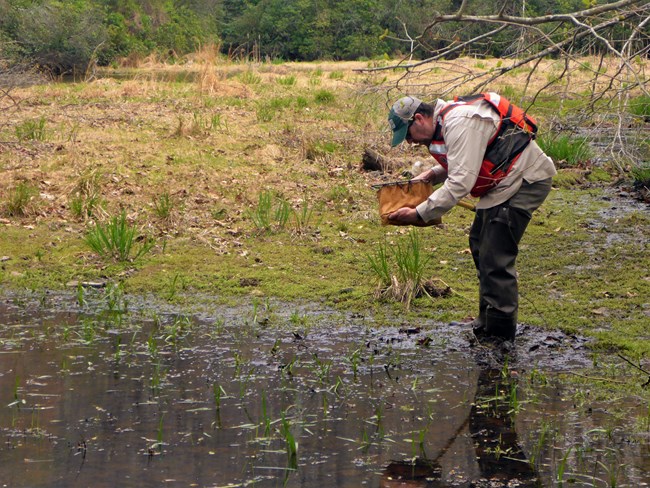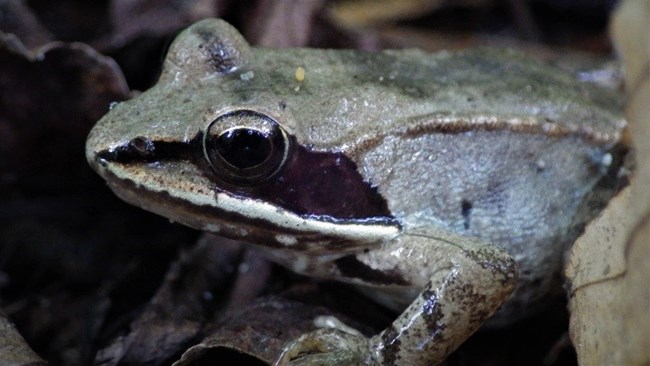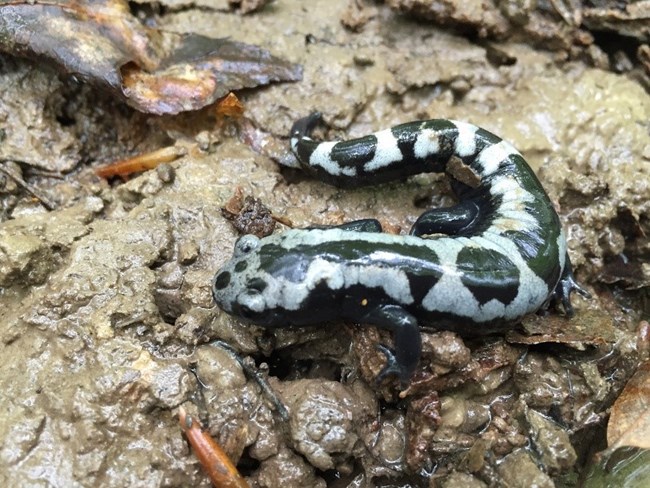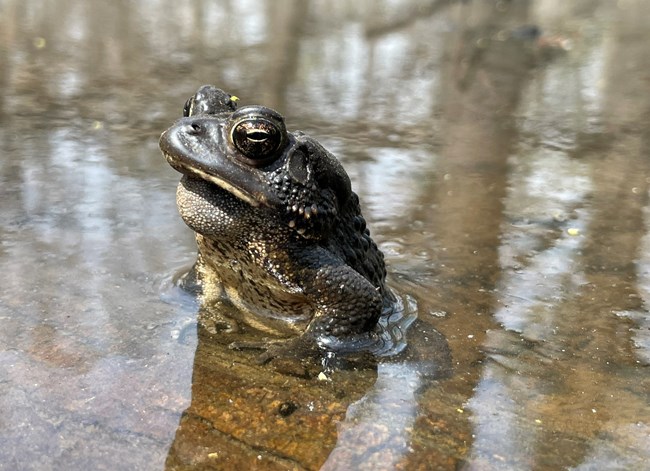Part of a series of articles titled Amphibian Monitoring in the National Capital Region.
Article
Amphibian Monitoring Update 2023
Nineteen years of monitoring in National Capital Region parks shows that amphibian populations are fairly stable.
By Crystal Chen, NCRN I&M Science Communication Intern

NPS / C. Shafer

NPS / L. Ashley
Decked out in a bright orange life jacket, Charles Shafer doesn’t have the same gear as most people traveling down the towpath at Chesapeake & Ohio Canal. He carries a clipboard in one hand, and a dipnet in the other. Curious visitors often stop and ask him, “What are you doing – and what’s that sound?”
Shafer, a biological technician with the US Geological Survey, studies amphibians. His “laboratory” is a vernal pool, and his “lab coat” includes a life jacket and waders. He’s looking (and listening) for amphibians – frogs, toads, and salamanders – and putting together the pieces of a much wider, and wetter, picture.

NPS / C. Shafer
Amphibians provide clues about ecosystem health
Amphibians (frogs, toads, and salamanders) begin their lives in the water before venturing on to land as adults. Because they are sensitive to small changes in both wet and dry habitats, amphibians are known as "indicator species" that tell us about ecosystem health.
We study long-term changes in amphibian populations to learn about amphibians and the condition of the natural resources they rely on. A two-for-one! Our monitoring asks -- “Which amphibian species are present in our parks? How are populations of these species changing over time?"
To answer these questions, amphibian researchers flip over mossy stones, look under leaves, and use dipnets to see what amphibians are living in streams and wetlands. Then, they analyze the data to determine occupancy trends.
But wait, what do we mean by “occupancy”? It’s the proportion of pools, out of all pools in a park, where a certain species lives.
Populations are stable, but dynamic
We surveyed 215 wetland pools and 26 stream sites in 2023. Since 2005, we have detected 15 frog, toad, and salamander species in wetland habitats and 5 salamander species in stream habitats in 10 parks. Annual fluctuations in species occupancy are natural and expected. Over the past 19 years, few species experienced severe decline or unexpected growth (see individual park summaries in this series).
Urbanization and climate change threaten amphibians
Together, NCR parks are more forested and have a larger number of breeding habitats than surrounding areas. The parks may act as refuge for species that would face more threats outside of these protected areas.

NPS / C. Shafer
Water quality is affected by human land-use (e.g., urbanization and agriculture), which contributes to higher levels of dissolved solids and pollutants. This increases the salinity, which in turn increases conductivity (the water’s capacity to conduct electricity). Amphibian skin is highly permeable to water and electrolytes, so they are very sensitive to small changes in water quality.
Roads can also split wetlands apart. Habitat fragmentation creates a burden for amphibians in their search for food and mating opportunities.
Longer, hotter summers may shorten the length of time that a wetland holds water, due to an increase in evaporation and drought and changes in precipitation patterns (Hayhoe et al. 2007).
Higher water temperatures, due to urbanization and changes in precipitation patterns, may also indirectly affect amphibian habitats. As water from large storm events rushes over paved and hardened surfaces, it heats up and sweeps pollutants into park waterways.
When faced with these large-scale threats, what can parks do to protect amphibians?
Helping amphibians with…surprise, sandbags!
Wetlands that are larger, closer together, and have lower water conductivity are better for amphibians. Amphibians thrive in wetlands that stay wet (i.e., have a long hydroperiod) throughout the breeding season, from March to July. Lengthening hydroperiods helps ensure that amphibians can complete metamorphosis, from tadpoles to adults.

NPS / C. Shafer
Approaches to extending wetland hydroperiods in dry years have been widely discussed (Shoo et al. 2011). Researchers at Patuxent Research Refuge, for example, have installed pond liners as one approach.
Supplementing water from developed sources is another option. Installing sandbags around a pool is a less intrusive approach (see image from Rock Creek Park). But, it can be harder for debris to break down, since the bottom substrate changes to a fine silt build-up on a thick mud bottom. In Oregon, people are turning to more naturalized approaches, including supporting beaver populations and use of beaver dam analogs.
When picking a strategy, the important thing is to keep in mind the environmental and structural constraints of each situation.

NPS / C. Shafer
With almost 20 years of amphibian data, we’ve been able to document and quantify trends that many had observed anecdotally or assumed were happening based on nearby areas. We’ve also identified many key characteristics of the ecosystems we study.
Going forward, this data and our continued monitoring of amphibians will allow us to make informed recommendations on how to best protect amphibian populations.
Glossary
- Hydroperiod: the amount of time a wetland stays wet
- Vernal pool: seasonal depressional wetlands, covered by shallow water for variable periods from winter to spring but may be completely dry for most of summer and fall
- Water conductivity: the water’s capacity to conduct electricity, used as a measure of the amount of salts and other materials—usually pollutants—dissolved in water
- Wetland connectivity: ability of amphibians to move across the landscape and reach suitable habitats
Tags
- antietam national battlefield
- catoctin mountain park
- chesapeake & ohio canal national historical park
- george washington memorial parkway
- harpers ferry national historical park
- manassas national battlefield park
- monocacy national battlefield
- national capital parks-east
- prince william forest park
- rock creek park
- ncrn
- nature
- science
- wildlife
- amphibian
- amphibian monitoring
- newt
- salamander
- frog
- toad
- i&m
- nature
- wetland
- stream
- vernal pool
- biodiversity
Last updated: March 15, 2024
